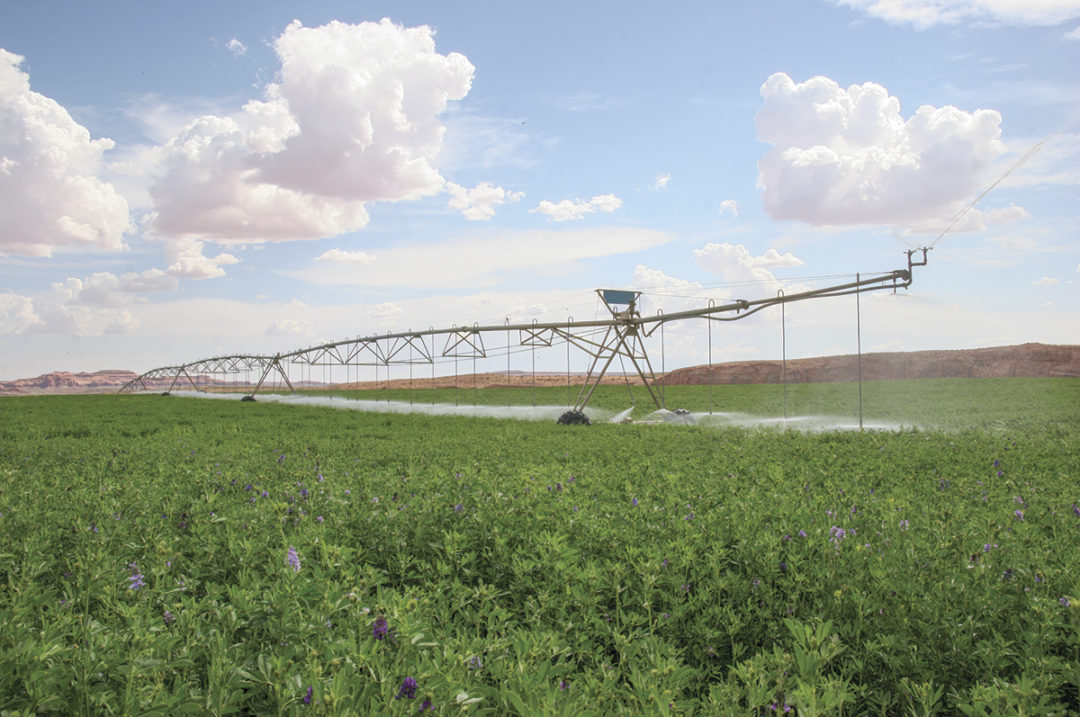Water resources have become a legitimate concern for U.S. agriculture. Recently published data shows that Utah’s Great Salt Lake has lost 74% of its water and has little chance of recovering to previous levels. In fact, the current trajectory actually suggests the lake could be completely dried up within the decade. This news comes on the heels of record-low levels in the Colorado River reservoirs of Lake Mead and Lake Powell triggering significant water cuts to the communities that rely on those resources. Arizona will see the largest cut, losing 592,000 acre-feet of water – no minor issue to the state that produced 260,000 acres of alfalfa in 2022.
While some may be content to engage in political finger-pointing and arguing whether or not a problem actually exists, others will realize the futility of that path and move on with adapting. It’s difficult to find a downside to making money with less water, after all. Here are some tips for those who just want to get on with it, already.
Ironically, a transition to hydroponically grown forages may be the greatest water conservation effort available. The indoor, fully contained systems use water very efficiently and are able to collect and recycle water that isn’t fully utilized by the plant. A quick internet search shows that there are several options available. Whether looking to grow forages differently or to purchase differently grown forage, options are available.
Strategic use
For those who wish to continue field-scale operations, the focus should be on water use efficiency, or maximizing the percentage of the water that actually makes it to the roots of the crop. Optimized irrigation strategies are the low-hanging fruit here, especially for anybody currently using flood irrigation. Any time water is exposed to the open air, it is evaporating. Storing irrigation water in tanks or reservoirs and using pumps to disperse the water through sprinklers is a very expensive endeavor with a significant decrease in losses to evaporation, thus an increase in water use efficiency. Even something as simple as irrigating at night can have a major impact on the amount of water lost to evaporation. For those who want to get really technical, variable-rate irrigation is an option that uses sensors in the soil and flow controllers on the irrigation pivot to adjust irrigation rates in real time based on feedback from the system.
When changing irrigation practices just isn’t feasible, it’s best to let economics and logic drive the strategy. According to Dan Putnam, University of California Cooperative Extension (UCCE) alfalfa and forage crop specialist in the department of plant sciences at UC – Davis, it makes the most sense to focus irrigation efforts on those fields where the payout will be better. This means focusing on younger alfalfa stands and the earlier cuttings at that. Putnam explains, “Alfalfa exhibits superior yield patterns early in the year, and this is also the period for highest quality.” He has found in his research that alfalfa can withstand drought much better than previously thought, and it’s acceptable to cease irrigations in midsummer and re-water later in the season when water becomes available without significant stand loss.
Soil health
Sound agricultural management will also play a key role in drought stress mitigation. In a convenient confluence of ecological hot topics, many of the soil health management principles that are currently in fashion will help aid in moisture conservation. The three most applicable principles are soil armor, minimizing soil disturbance and increasing plant diversity. Soil armor, commonly referred to as soil residue, is a great way to stop water loss because the sun will not beat down directly on the soil surface and cause evaporation. An added benefit to soil armor is a cooler temperature at the soil surface and in the crop canopy, leading to less transpiration water loss. Minimizing soil disturbance through tillage will also limit the soil’s moisture loss, as opening up the soil causes increased surface drying with each tillage pass. Limiting excess tillage passes will increase the amount of water retained in the soil profile at the time of planting and throughout the growing season.
Crop selection
Plant diversity can come in several forms. This can be something as obvious as crop selection. A corn-alfalfa rotation may be the most profitable short-term option, but it is also a very thirsty rotation. Adding in wheat or rye for grain or forage followed by a high-quality fall-harvested cover crop is a great addition to any forage-based rotation. The sorghum species were adapted to be more drought-tolerant and will always have a place in a water-limited system. A diverse rotation also places less weight on the performance of each crop, meaning that if one fails because of drought, there will be less yield loss than if there are only two crops in the rotation.
Once crops are selected, many choices thereafter will affect the crop’s drought tolerance. Something as simple as planting time will make a big difference when it comes to making – or breaking – a crop. Getting plants up and out of the ground in the moist early spring soil and when potential spring rains are present will get the crop off to a good start before the heat of summer. Variety selection will also aid in limiting water-related problems. Selecting a range of maturity levels will help spread drought risk by spreading out the pollination window. A number of seed companies also offer drought-tolerant hybrids. While these plants still need water to grow, they are often more tolerant than traditional hybrids of being shorted of water. Consult with your seed dealer when it comes to variety selection. They may have suggestions on hybrids that have a flexible nature and will adapt to the in-season moisture levels. These hybrids may not be marketed as drought-tolerant but will still help save yield come harvest time.
Of course, chemical help is also an option with water use efficiency, but there is an economic tradeoff and this strategy is best suited to high-value crops. Evapotranspiration, the mechanism that moves water from the soil through the plant and out the stomata of the leaves, can happen too fast in hot weather conditions and limit the plant’s benefit from the water. Adjuvants are now commercially available to help control that rate of evapotranspiration and have proven to be a component of successful water management strategies. These foliar-applied adjuvants work by creating an ultra-thin protective film on the leaves, helping guard against excessive evaporation from the leaves.
Let’s be clear – nobody is saying that water limits to agriculture production is going to be an easy transition. Further, making a transition to alternative or alternatively grown forages will not be a simple plug-and-play operation. These forages will have different properties, and animal diets will need to be formulated accordingly. Work will need to be done but, like any major shift in ideology, those who lead the charge will be positioned to reap the benefits and become mentors to the late adapters.












